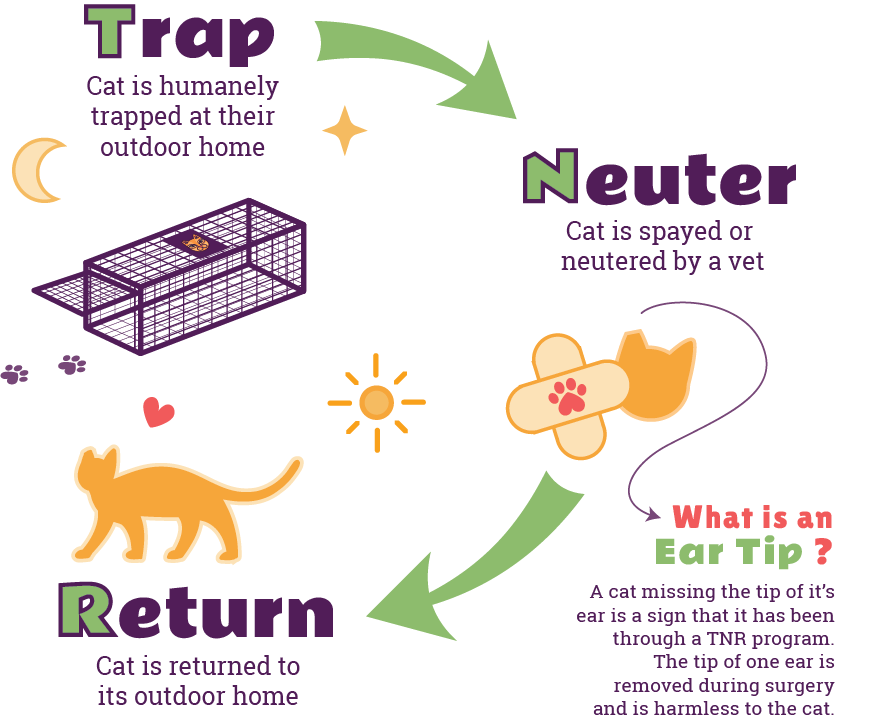TNR stands for Trap-Neuter-Return: a proven, humane method to stop the endless cycle of stray and feral cats being born outdoors.
Instead of removing cats (which only makes space for more to move in), we work to stabilize colonies by:
- Humanely trapping cats in their existing environment
- Bringing them to trusted clinics to be spayed or neutered
- Vaccinating and ear-tipping them for health and identification
- Returning them to the spot they came from
TNR process pointers:
Making a plan is more effective.
Assess the colony: count how many cats need TNR appointments. Depending on the accommodations, TNR jobs can be done all at once or in batches.
Assess the colony: count how many cats need TNR appointments. Depending on the accommodations, TNR jobs can be done all at once or in batches.
Coordinating with colony managers is essential.
Food should be withheld the day before trapping, which increases your chance of catching the cats. Colony managers know the routine and can help.
Once a surgery spot is confirmed, TNR typically takes 2–4 days.
Cats are trapped the night before surgery, then recover for 24–48 hours before being returned.
Cats are trapped the night before surgery, then recover for 24–48 hours before being returned.
Cats are trapped in humane cat traps.
It’s a live animal trap designed to safely catch cats without harming them. We use powder-coated, wire-mesh traps with soft liners and towel covers for comfort. Our preferred brand is TruCatch. Traps are covered with a towel to reduce visibility and stress on the cat.
It’s a live animal trap designed to safely catch cats without harming them. We use powder-coated, wire-mesh traps with soft liners and towel covers for comfort. Our preferred brand is TruCatch. Traps are covered with a towel to reduce visibility and stress on the cat.
Cats remain in their trap at all times, and need to be transported with care.
Vehicles need to have air circulation (e.g. fold-down seats in a car) and can secure the trap flat. Never transport a cat in a truck bed. Drive gently to reduce stress.
Vehicles need to have air circulation (e.g. fold-down seats in a car) and can secure the trap flat. Never transport a cat in a truck bed. Drive gently to reduce stress.
Cats CAN NOT have a meal before surgery.
If surgery is the next morning, food must be removed from their trap by 8–9 PM the night before. This is important for safe anesthesia
If surgery is the next morning, food must be removed from their trap by 8–9 PM the night before. This is important for safe anesthesia
Cats need a safe holding area before and after surgery.
This is where they need to recover before returning to their outside home. It can be a temperature controlled spare room, garage, or bathroom. Keeping it quiet keeps them calmer during the process.
This is where they need to recover before returning to their outside home. It can be a temperature controlled spare room, garage, or bathroom. Keeping it quiet keeps them calmer during the process.
After recovery, cats return to the EXACT location they were trapped.
They may need a minute to adjust or will run out of the trap immediately. Either way, timing and location are important to consider for their safety.
They may need a minute to adjust or will run out of the trap immediately. Either way, timing and location are important to consider for their safety.
TNR does not hurt the cat.
Cats undergo standard spay/neuter surgery and an ear tip — both are safe and commonly done. Some may stress themselves in the trap trying to escape, which is why we use towels to help them feel calm and secure.
Cats undergo standard spay/neuter surgery and an ear tip — both are safe and commonly done. Some may stress themselves in the trap trying to escape, which is why we use towels to help them feel calm and secure.
An ear tip is a painless surgical trim of the right ear done during spay/neuter to mark the cat as fixed.
It’s a universal TNR symbol and helps caretakers identify sterilized cats from a distance. Most places tip the left ear, but we do the right ear in El Paso.
It’s a universal TNR symbol and helps caretakers identify sterilized cats from a distance. Most places tip the left ear, but we do the right ear in El Paso.
Protect yourself and the cats!
Some important reminders:
- Never attempt to pick up a feral cat
- Never touch a trapped cat
- Never use tranquilizers to trap a cat
- Never transport in the back of an open truck
- Never return a cat facing a busy area


